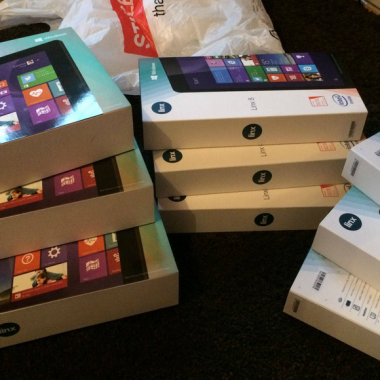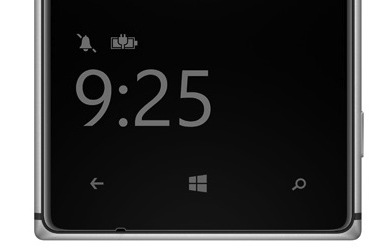
User story: the shattered image
“Oh yeah, that went a long time ago,” the dad said when I asked him about the spider’s web of cracks spreading out from the corner of the iPad’s screen. He seemed resigned to the fate of the expensive tablet, as if its demise had been inevitable in the family environment.
His daughter, holding the iPad in both hands seemed unfazed by the weird patterns and reflections caused by the shattered glass. She carried on jabbing at the screen with alternating finger tips on each hand, playing a game with the lightening reaction speeds which seem innate to a generation raised on interacting through glass.
Corning, the glass manufacturer best known for its ‘Gorilla’ touchscreens, estimate over 4 billion square feet of glass was produced in 2013 to meet demand for digital displays. The figure is growing every year as individual displays expand in size, new product categories adopt touchscreens and sales of smart devices march ever upwards.
However, for all the advances in scratch and shatter resistance, touchscreens remain vulnerable to drops. As a result, we are surrounded as much by the jagged imperfection of broken panels as by the seductively smooth experience of a brand new display fresh from the assembly line.
There is a direct impact on user experience. Interactions are shaped by the infinitely unique ways in which glass cracks, leaving dead zones on the display which are unresponsive to touch, or portions of the screen which become impossible to read beneath the damage. It would be naively optimistic to imagine the interaction surface users employ to navigate your digital services is the glossy, unmarked panel seen in manufacturer’s advertisements.
Nor is it limited to display panels. Another user I spoke with explained how he remained mystified by the fractured camera lens of his 3 month-old smartphone. “I’m really careful with it. It was fine, then the next day I picked it up and I found it like this. So I asked both of my so-called ‘housemates’…” he joked, referring to his young son and wife, who often use his phone, “…and they both denied all knowledge.”
The camera function itself still works, but instead of the sharp 13 megapixels images it once produced, it has now given rise to an abstract art form, where images are clouded in a 1970s-style haze. “I’m gutted. I’d never take out a separate camera, so this was my only way of taking photos. I spoke to a place and they said it would cost about 40 euros to repair, so I’ll probably have to do that.”
His iPad Mini, sitting on the table in front of him, also had a single, deep crack running the full width of the device. It happened within a few months of acquiring the device, courtesy of the youngest member of his household.
The 150 year old British retail chain Timpson (pictured above) was, until recently, best known as a shoe repairer and place to have keys cut. Today, the most prominent signs in its shop windows are advertisements for screen repair services, offering to fix all those broken smartphones in the same way they used to reheel a pair of worn out shoes.
Smartphone manufacturer HTC offers a warranty feature called ‘UH OH‘ in the US, guaranteeing they will replace or repair a user’s device for free if they break the screen within the first 12 months.
A common thread running through instances of broken glass is young kids. In many cases the screen was smashed directly by the child, but in others it was simply a victim of the frantic lifestyle which often goes hand-in-hand with the early years of a new family. Tablets are dropped as parents rush out of the door. Phones fall to the ground when hands are full with other things.
In other stages of life, breakages are less frequent, but the influence of fragile glass exhibits itself in other ways.
“If I get a new one, I shall be really careful with it this time. I’m going to get a proper case,” a lady in her early 60s told me. The screen of her two year old Sony Ericsson smartphone had cracked a few months into its life, leaving a fissure from edge to edge about a third of the way down the display. She’d persevered with it though, and was only now looking for a new phone because the charging port of this one had broken, leaving it unable to charge.
Investing in a substantial case had protected her tablet from a few falls and now she intended to apply something similarly robust to her new phone. Cases influence how users hold their devices, the activities they undertake with them and the places they’re willing to use them.
There’s a strong link between the perceived fragility of a device and the type of cases a user employs. It has given rise to a new category of accessories manufactured from heavy rubber and shockproof padding, designed specifically for young families. They offer levels of protection hitherto associated with industrial and field deployments, or obtainable only by purchasing specialist rugged devices. Now it is possible to buy thick bumpers which completely encase even something as a delicate as an iPad Air and make it virtually childproof.
Pixels may be the new ink and paint, but glass – with all its attendant properties – is now lens, paper and canvas combined.




Subsequently found out about Amazon’s Kindle Fire Kids Edition, with its two year ‘worry free’ guarantee to cover breakages and integrated thick rubber casing. Interesting example.